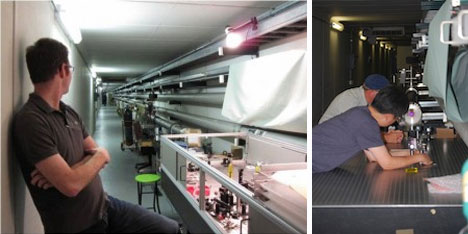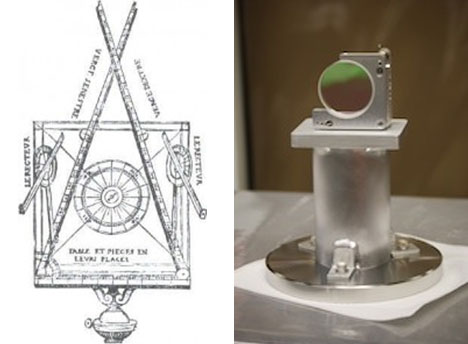 Knowledge is power.iStockphoto
Knowledge is power.iStockphotoThe laws of physics say that you can't get energy for nothing — worse still, you will always get out of a system less energy than you put in. But a nanoscale experiment inspired by a nineteenth-century paradox that seemed to break those laws now shows that you can generate energy from information.
Masaki Sano, a physicist at the University of Tokyo, and his colleagues have demonstrated that a bead can be coaxed up a 'spiral staircase' without any energy being directly transferred to the bead to push it upwards. Instead, it is persuaded along its route by a series of judiciously timed decisions to change the height of the 'steps' around it, based on information about the bead's position. In this sense, "information is being converted to energy", says Sano. The work is published by Nature Physics today1.
The team's set-up was inspired by a nineteenth-century thought experiment proposed by Scottish physicist James Clerk Maxwell, which — controversially, at the time — suggested that information could be converted into energy. In the thought experiment, a demon guards a door between two rooms, each filled with gas molecules. The demon allows only fast-moving gas particles to pass out of the room on the left and into the room on the right, and only slow-moving particles to pass in the opposite direction.
As a result, the room on the right gradually gets warmer as the average speed of particles in that room increases, and the room on the left gets colder. The demon thus creates a difference in temperature without ever imparting any energy directly to the gas molecules — simply by knowing information about their speeds. This seems to violate the second law of thermodynamics, which states that you cannot make a system more ordered without any energy input.
A paradox put into practice
To create a real-life version of the demon experiment, Sano and his colleagues placed an elongated nanoscale polystyrene bead, which could rotate either clockwise or anticlockwise, into a bath of buffer solution. The team applied a varying voltage around the bead, making it progressively harder for the bead to rotate a full 360 degrees in the anticlockwise direction. This effectively created a "spiral staircase" that was harder to "climb up" in the anticlockwise direction than to "fall down" in the clockwise direction, says Sano.
“This is a beautiful experimental demonstration that information has a thermodynamic content.”
When left alone, the bead was randomly jostled by the surrounding molecules, sometimes being given enough of a push to turn anticlockwise against the voltage — or jump up the stairs — but more often turning clockwise — or going "downstairs". But then the team introduced their version of Maxwell's demon.
They watched the motion of the bead, and when it randomly turned anticlockwise they quickly adjusted the voltage — the equivalent of Maxwell's demon slamming the door shut on a gas molecule — making it tougher for the bead to turn back clockwise. The bead is thus encouraged to keep climbing "upstairs", without any energy being directly imparted to the bead, says Sano.
The experiment does not actually violate the second law of thermodynamics, because in the system as a whole, energy must be consumed by the equipment — and the experimenters — to monitor the bead and switch the voltage as needed. But it does show that information can be used as a medium to transfer energy, says Sano. The bead is driven as a mini-rotor, with a information-to-energy conversion efficiency of 28%.
"This is a beautiful experimental demonstration that information has a thermodynamic content," says Christopher Jarzynski, a statistical chemist at the University of Maryland in College Park. In 1997, Jarzynski formulated an equation to define the amount of energy that could theoretically be converted from a unit of information2; the work by Sano and his team has now confirmed this equation. "This tells us something new about how the laws of thermodynamics work on the microscopic scale," says Jarzynski.
Vlatko Vedral, a quantum physicist at the University of Oxford, UK, says that it will be interesting to see whether the technique can be used to drive nanomotors and artificial molecular machines. "I would also be excited to see whether something like this is already at work in nature," he says. "After all, you could say that all living systems are 'Maxwell's demons', trying to defy the tendency for order to turn back into randomness."
References
- Toyabe, S. , Sagawa, T. , Ueda, M. , Muneyuki, E. & Sano, M.Nature Physics doi:10.1038/NPHYS1821 (2010).
- Jarzynski, C. Phys. Rev. Lett. 78, 2690-2693 (1997).
 Quick review. In the 19th century once the idea that humans were derived from non-human ancestral species was injected into the bloodstream of the intellectual classes there was an immediate debate as to the location of the proto-human homeland; the Urheimat of us all. Charles Darwin favored Africa, but in many ways this ran against the cultural grain. The theory of evolution was birthed before the highest tide of the age of white supremacy and European hegemony, and Darwin’s model had to swim against the conviction that Africans were the most primitive of the colored races. After the waning of the ideological edifice of white supremacy, and the shock it received during and after World War II, the debates as to the origin of humanity still remained contentious and followed the same outlines (though without the charged normative inferences). But as the decades wore on many more researchers began to believe that Darwin was correct, and that the origin of humanity lay in the African continent. First, the deep origin of the human lineage in Africa was accepted, but eventually a more recent expansion out of Africa was argued for by one school. The turning point in these academic disputes was the popularization of the“mitochondrial Eve” theory of the 1980s.
Quick review. In the 19th century once the idea that humans were derived from non-human ancestral species was injected into the bloodstream of the intellectual classes there was an immediate debate as to the location of the proto-human homeland; the Urheimat of us all. Charles Darwin favored Africa, but in many ways this ran against the cultural grain. The theory of evolution was birthed before the highest tide of the age of white supremacy and European hegemony, and Darwin’s model had to swim against the conviction that Africans were the most primitive of the colored races. After the waning of the ideological edifice of white supremacy, and the shock it received during and after World War II, the debates as to the origin of humanity still remained contentious and followed the same outlines (though without the charged normative inferences). But as the decades wore on many more researchers began to believe that Darwin was correct, and that the origin of humanity lay in the African continent. First, the deep origin of the human lineage in Africa was accepted, but eventually a more recent expansion out of Africa was argued for by one school. The turning point in these academic disputes was the popularization of the“mitochondrial Eve” theory of the 1980s.






